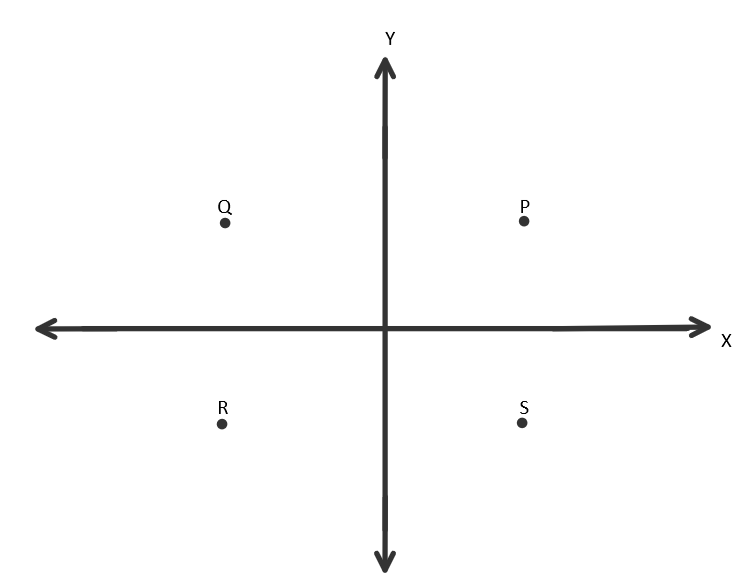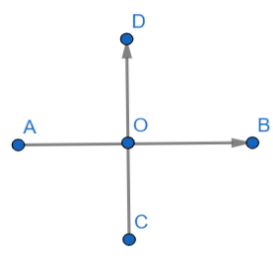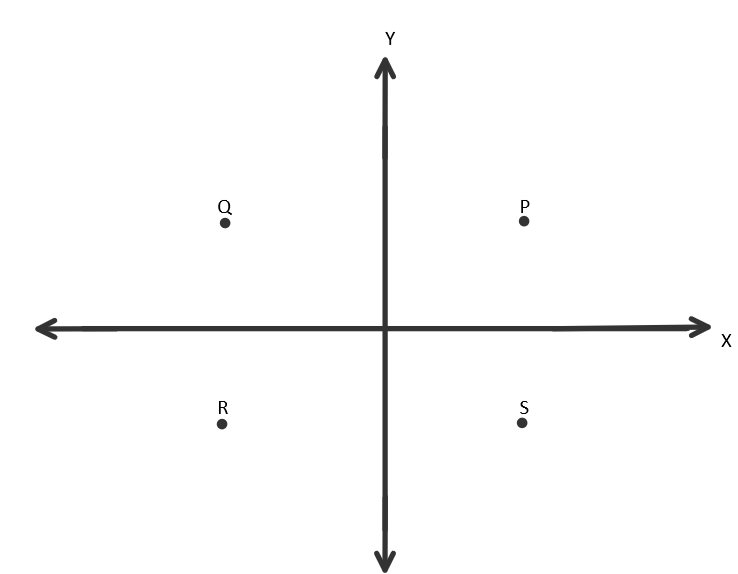
The diagram shows the four quadrants P, Q, R and S on a Cartesian plane. Which of the following points lie in the quadrant S?
\[\begin{align}
& \text{I (-1,2) II (-1,-2)} \\
& \text{III (1,-2) IV (2,-1) } \\
\end{align}\]

\[\begin{align}
& \text{(A) I and II only} \\
& \text{(B) I and IV only} \\
& \text{(C) II and III only} \\
& \text{(D) III and IV only} \\
\end{align}\]

Answer
586.2k+ views
Hint: From the given point, we have to find whether the abscissa and ordinate is greater than zero (or) less than zero. Once the sign of the abscissa and ordinate is determined, we can say in which quadrant the given point lies on the coordinate system.
Complete step-by-step solution -
Before solving the question, we should have an idea of the concept of quadrants.
Let us assume a point \[\text{A(}{{\text{x}}_{1}},{{\text{y}}_{1}})\]in the coordinate system.

A point \[\text{A(}{{\text{x}}_{1}},{{\text{y}}_{1}})\]is said to be in \[{{1}^{st}}\] quadrant if the point lies in the region DOB.
A point \[\text{A(}{{\text{x}}_{1}},{{\text{y}}_{1}})\]is said to be in \[{{2}^{nd}}\] quadrant if the point lies in the region DOA.
A point \[\text{A(}{{\text{x}}_{1}},{{\text{y}}_{1}})\]is said to be in \[{{3}^{rd}}\] quadrant if the point lies in the region COA.
A point \[\text{A(}{{\text{x}}_{1}},{{\text{y}}_{1}})\]is said to be in \[{{4}^{th}}\] quadrant if the point lies in the region COB.
A point \[\text{A(}{{\text{x}}_{1}},{{\text{y}}_{1}})\]is said to be \[{{1}^{st}}\] quadrant if \[{{x}_{1}}>0,{{\text{y}}_{1}}>0\].
A point \[\text{A(}{{\text{x}}_{1}},{{\text{y}}_{1}})\]is said to be \[{{2}^{nd}}\] quadrant if \[{{x}_{1}}<0,{{\text{y}}_{1}}>0\].
A point \[\text{A(}{{\text{x}}_{1}},{{\text{y}}_{1}})\]is said to be \[{{3}^{rd}}\] quadrant if \[{{x}_{1}}<0,{{\text{y}}_{1}}<0\].
A point \[\text{A(}{{\text{x}}_{1}},{{\text{y}}_{1}})\]is said to be \[{{4}^{th}}\] quadrant if \[{{x}_{1}}>0,{{\text{y}}_{1}}<0\].

From the above diagram, it is clear that
Region P represents \[{{1}^{st}}\] quadrant.
Region Q represents \[{{2}^{nd}}\] quadrant.
Region R represents \[{{3}^{rd}}\] quadrant.
Region S represents \[{{4}^{th}}\]quadrant.
We have given four points in the question.
\[\begin{align}
& \text{I (-1,2) II (-1,-2)} \\
& \text{III (1,-2) IV (2,-1) } \\
\end{align}\]
We have to compare each and every point with \[\text{A(}{{\text{x}}_{1}},{{\text{y}}_{1}})\].
From \[\text{I (-1},2)\], we can say that \[{{x}_{1}}=-1,{{y}_{1}}=2\] .In this point, \[{{x}_{1}}<0,{{\text{y}}_{1}}>0\]. Hence, \[\text{I (-1},2)\] is said to be in \[{{2}^{nd}}\] quadrant.
From \[\text{II (-1},-2)\], we can say that \[{{x}_{1}}=-1,{{y}_{1}}=-2\].In this point, \[{{x}_{1}}<0,{{\text{y}}_{1}}<0\]. Hence,\[\text{II (-1},-2)\] is said to be in \[{{3}^{rd}}\] quadrant.
From \[\text{III (1},-2)\], we can say that \[{{x}_{1}}=1,{{y}_{1}}=-2\] .In this point, \[{{x}_{1}}>0,{{\text{y}}_{1}}<0\]. Hence,\[\text{III (1},-2)\] is said to be in \[{{4}^{th}}\] quadrant.
From \[\text{IV (2},-1)\], we can say that \[{{x}_{1}}=2,{{y}_{1}}=-1\] .In this point, \[{{x}_{1}}>0,{{\text{y}}_{1}}>0\]. Hence,\[\text{IV (2},-1)\] is said to be in\[{{4}^{th}}\] quadrant.
So, we can say that \[\text{III (1},-2)\] and \[\text{IV (2},-1)\] are in the region S.
Hence points \[\text{III}\] and \[\text{IV}\]are the point lie in the region S.
Hence, option (D) is correct.
Note: Remember that if the abscissa of a point is equal to zero, then the point is said to lie on the y-axis but not in any of the four quadrants. If the ordinate of a point is equal to zero, then the point is said to lie on the x-axis but not in any of the four quadrants. So, a point is said to be any of the four quadrants if and only if the abscissa and ordinate should not be equal to zero.
Complete step-by-step solution -
Before solving the question, we should have an idea of the concept of quadrants.
Let us assume a point \[\text{A(}{{\text{x}}_{1}},{{\text{y}}_{1}})\]in the coordinate system.

A point \[\text{A(}{{\text{x}}_{1}},{{\text{y}}_{1}})\]is said to be in \[{{1}^{st}}\] quadrant if the point lies in the region DOB.
A point \[\text{A(}{{\text{x}}_{1}},{{\text{y}}_{1}})\]is said to be in \[{{2}^{nd}}\] quadrant if the point lies in the region DOA.
A point \[\text{A(}{{\text{x}}_{1}},{{\text{y}}_{1}})\]is said to be in \[{{3}^{rd}}\] quadrant if the point lies in the region COA.
A point \[\text{A(}{{\text{x}}_{1}},{{\text{y}}_{1}})\]is said to be in \[{{4}^{th}}\] quadrant if the point lies in the region COB.
A point \[\text{A(}{{\text{x}}_{1}},{{\text{y}}_{1}})\]is said to be \[{{1}^{st}}\] quadrant if \[{{x}_{1}}>0,{{\text{y}}_{1}}>0\].
A point \[\text{A(}{{\text{x}}_{1}},{{\text{y}}_{1}})\]is said to be \[{{2}^{nd}}\] quadrant if \[{{x}_{1}}<0,{{\text{y}}_{1}}>0\].
A point \[\text{A(}{{\text{x}}_{1}},{{\text{y}}_{1}})\]is said to be \[{{3}^{rd}}\] quadrant if \[{{x}_{1}}<0,{{\text{y}}_{1}}<0\].
A point \[\text{A(}{{\text{x}}_{1}},{{\text{y}}_{1}})\]is said to be \[{{4}^{th}}\] quadrant if \[{{x}_{1}}>0,{{\text{y}}_{1}}<0\].

From the above diagram, it is clear that
Region P represents \[{{1}^{st}}\] quadrant.
Region Q represents \[{{2}^{nd}}\] quadrant.
Region R represents \[{{3}^{rd}}\] quadrant.
Region S represents \[{{4}^{th}}\]quadrant.
We have given four points in the question.
\[\begin{align}
& \text{I (-1,2) II (-1,-2)} \\
& \text{III (1,-2) IV (2,-1) } \\
\end{align}\]
We have to compare each and every point with \[\text{A(}{{\text{x}}_{1}},{{\text{y}}_{1}})\].
From \[\text{I (-1},2)\], we can say that \[{{x}_{1}}=-1,{{y}_{1}}=2\] .In this point, \[{{x}_{1}}<0,{{\text{y}}_{1}}>0\]. Hence, \[\text{I (-1},2)\] is said to be in \[{{2}^{nd}}\] quadrant.
From \[\text{II (-1},-2)\], we can say that \[{{x}_{1}}=-1,{{y}_{1}}=-2\].In this point, \[{{x}_{1}}<0,{{\text{y}}_{1}}<0\]. Hence,\[\text{II (-1},-2)\] is said to be in \[{{3}^{rd}}\] quadrant.
From \[\text{III (1},-2)\], we can say that \[{{x}_{1}}=1,{{y}_{1}}=-2\] .In this point, \[{{x}_{1}}>0,{{\text{y}}_{1}}<0\]. Hence,\[\text{III (1},-2)\] is said to be in \[{{4}^{th}}\] quadrant.
From \[\text{IV (2},-1)\], we can say that \[{{x}_{1}}=2,{{y}_{1}}=-1\] .In this point, \[{{x}_{1}}>0,{{\text{y}}_{1}}>0\]. Hence,\[\text{IV (2},-1)\] is said to be in\[{{4}^{th}}\] quadrant.
So, we can say that \[\text{III (1},-2)\] and \[\text{IV (2},-1)\] are in the region S.
Hence points \[\text{III}\] and \[\text{IV}\]are the point lie in the region S.
Hence, option (D) is correct.
Note: Remember that if the abscissa of a point is equal to zero, then the point is said to lie on the y-axis but not in any of the four quadrants. If the ordinate of a point is equal to zero, then the point is said to lie on the x-axis but not in any of the four quadrants. So, a point is said to be any of the four quadrants if and only if the abscissa and ordinate should not be equal to zero.
Recently Updated Pages
Master Class 9 Social Science: Engaging Questions & Answers for Success

Master Class 9 Science: Engaging Questions & Answers for Success

Master Class 9 English: Engaging Questions & Answers for Success

Master Class 9 Maths: Engaging Questions & Answers for Success

Master Class 11 Economics: Engaging Questions & Answers for Success

Master Class 11 English: Engaging Questions & Answers for Success

Trending doubts
Which places in India experience sunrise first and class 9 social science CBSE

Fill the blanks with the suitable prepositions 1 The class 9 english CBSE

Write the 6 fundamental rights of India and explain in detail

Difference Between Plant Cell and Animal Cell

What is the Full Form of ISI and RAW

Golden Revolution is related to AFood production BOil class 9 social science CBSE





